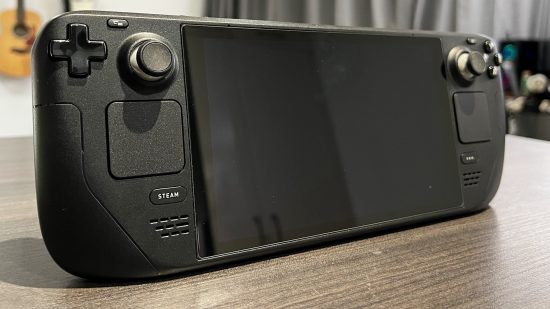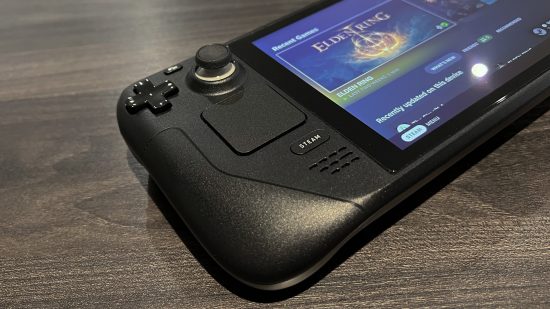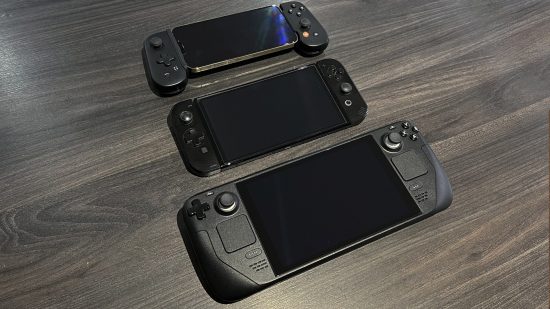2022 was a milestone year for PC gaming thanks to Valve and AMD, who managed to take a low-end PC and shrink it down to a surprisingly powerful handheld that can run the latest AAA games. Coming in at 669 grams and almost 30cm wide, the Steam Deck is one of the biggest handhelds we’ve ever used, but we’d still count it as one of the best portable gaming consoles in 2023. Packing a seven-inch touch screen, trackpads, and more buttons than an Xbox Elite Controller, Valve has covered every base without compromising comfort.
At a glance, the Steam Deck’s button placement might seem confusing to someone who hasn’t had a chance to try it. Most handhelds tend to keep the buttons towards the middle of the device, whereas the Steam Deck shifts everything except the trackpads to the top. The end result is a handheld that fits perfectly in your hands as your fingers naturally rest on top of each button. The Steam Deck’s familiar and intuitive design makes it feel like a professional-grade controller, suitable for any genre.
While it’s incredible that Valve has managed to squeeze so much into the Steam Deck, there are blatant compromises that keep the cheapest Steam Deck under £350 / $400. The 1280×800 IPS screen is definitely one of the Steam Deck’s weaker points, making the device feel outdated compared to most modern mobile phones which have opted for OLED screens. Not only does the screen lack the perfect black levels and vibrant colours exclusive to OLED panels, the 60Hz display features faint ghosting when playing fast-paced games.
The overall size and weight of the Steam Deck are also a tricky thing to balance – the device lasts two to eight hours on a single charge, but this varies depending on which game you’re playing. Demanding titles like Elden Ring will deplete your battery much faster than a game like Spelunky 2.
Considering the Steam Deck is over twice the weight of the Nintendo Switch OLED, Valve has reached the maximum weight that a handheld should be. After a few hours, your arms are definitely going to ache, and you also need a reasonably-sized backpack if you intend to use it outside.
There are three tiers of storage: 64GB, 256GB, and 512GB. However, there’s very little to differentiate between the three models. The 256GB and 512GB versions each feature NVMe SSDs, with the highest capacity model sporting a slightly faster one. The 512GB also comes with anti-glare etched glass, but we can barely tell the difference in a side-by-side comparison. We recommend going for the 256GB model and purchasing a micro SD card to get the best bang for your buck.
Given the technology available, it’s clear manufacturers require a lot of processing power to build a handheld computer. There are lots of alternative Steam Deck options on the market, but comparable devices like the Aya Neo Next can cost over £1,000+ / $1,400. It’s hard to argue these handhelds offer twice the value of the 512GB Steam Deck, and then you need to factor in warranty and repairability.
To put it plainly, the repairability of the Steam Deck is unprecedented in this market. The Steam Deck comes with a one-year warranty for any hardware defects you may experience, and to top it off, every component, along with detailed repair guides, has been made available by Valve on the iFixIt website. Similar to building a PC, you can upgrade the Steam Deck at your leisure, whether it’s swapping out its SSD for a larger one or replacing the analog sticks. Unlike the Nintendo Switch, you also have a wide range of docks and USB Type C hubs that let you output to an external display.
Docking the Steam Deck allows you to push the hardware to its limits, giving you room to play around with resolutions and different graphics presets. Unsurprisingly, there aren’t many games on the Steam Deck that can run smoothly at 4K, but if you stick to 1080p you should have no problems running most games. Once you connect wireless controllers to the system via Bluetooth or using adapters in the dock itself, the Steam Deck’s UI on a television works just as well as any modern console.
Speaking of modern consoles, there’s nothing worse than buying a new gaming device and having nothing to play on it. One of the main draws of the Steam Deck is that you already have plenty of games to play straight away. If you’ve dabbled in PC gaming since Steam launched in 2003, chances are you’ve built a healthy backlog of discounted games and Humble Bundles.
While it’s unlikely your entire library can be used on the Steam Deck, a good chunk of your games along with your cloud saves can be accessed on the handheld. If you’re just starting out, there’s a bunch of free PC games to try before you inevitably blow your entire paycheck on your first big Steam sale.
The Steam Deck runs on SteamOS, a custom-built version of Linux rather than Windows, but that’s not as bad as it might sound to the uninitiated. The handheld comes pre-loaded with Steam, which makes it easy to set up and navigate your library: all you need to do is log into your Steam account and begin downloading games. The Steam Deck launched with a long list of compatible games and Valve has verified thousands more since, from classics like Stardew Valley to brand-new PC releases like Marvel’s Spider-Man: Miles Morales.
If you’re willing to put the time in, the Steam Deck can be unlocked to go beyond SteamOS. If you have a collection of Epic Game Store titles, you can use your library on Linux using Heroic Games Launcher, an open-source launcher for Epic and GoG games. Emulation is also one of Steam Deck’s biggest strengths, and by using the right software you can have your favorite classic games running seamlessly.
While the Steam Deck runs Linux as its primary operating system, there’s nothing stopping you from running Windows on an external micro SD card. The Windows experience on a Steam Deck is far from perfect, but it’s good enough to make previously incompatible games like Warzone 2.0 and Forza Horizon 5 playable.
This latest generation of game consoles has not only brought about higher standards of graphics, but we’ve also seen developers pay careful attention to optimization and scalability. Valve’s Steam Deck has heavily benefitted from these breakthroughs, allowing the portable device to run brand-new games alongside the Xbox Series X and PlayStation 5.
Steam Deck review
There are some trade-offs, but for a first attempt at a handheld device, Valve has smashed it out of the park. The Steam Deck is an incredible achievement, and it’s currently impossible to find a worthy competitor that packs this many features into an affordable package.















